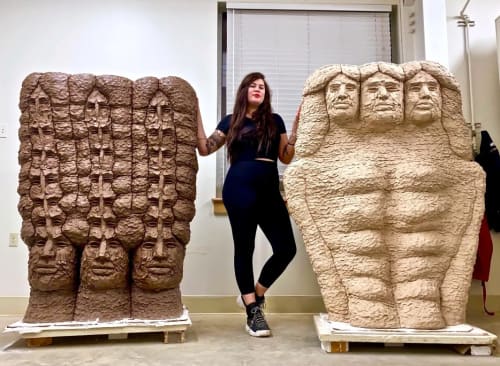Indigenous artist Raven Halfmoon (Caddo Nation) has had a long love affair with ceramics. She was exposed to the craft growing up as a teen in Norman, Oklahoma. “My mom took me to see one of our elders, Jeri Redcorn,” Halfmoon says. “She’s a phenomenal artist and makes traditional pottery. I remember going to her house, and we made these pots that were just so fun to make. That was my first time handling clay.” Halfmoon later went on to study anthropology, ceramics, and painting, but she found herself increasingly drawn to clay, and the material has since become the focus of her work as an artist. “I like to see human touch in a material, and I like the physicality of clay,” she says. “I’m very tactile—maybe it’s the Cancer in me.”
Halfmoon’s tribe—the Caddo tribe—also has a rich history with ceramics, especially with pottery. “My tribe has been making pottery for thousands of years,” she says. “It’s such an ancient material, and I think of how my family before me did this. We have all touched clay, and that inherently transported to my hands.” While the artist’s approach to ceramics certainly mimics the traditional work of her ancestors, Halfmoon’s approach is decidedly more contemporary. She creates large-scale sculptures of Indigenous figures that command a room—and the striking creations are now on view in a new solo exhibition at the Ross+Kramer Gallery in Chelsea.
“Okla Homma to Manahatta,” which opens today and will be up through February 6, is Halfmoon’s first solo exhibit in New York City. As the title suggests, it examines the tension between the old and the new—exploring her traditional education in Oklahoma and how it translates to a concrete jungle like Manhattan. Being a contemporary artist, she says she often feels this division while creating—a duty to carry her tribe’s craftwork forward into the modern day, while respecting and acknowledging her people’s history. “There’s always this entanglement of being a millennial and sharing this history,” she says. “A lot of the figures have a stoic or confrontational face. Being alone in the studio and reading about what happened to our ancestors, it’s heavy material.”
The exhibit features 10 Halfmoon pieces in total, including a mix of small- and large-scale works. The stoneware sculptures were all made in Helena, Montana, where Halfmoon is currently doing a clay residency at the Archie Bray Foundation. Halfmoon’s large-scale works in the exhibit are a particular standout: Some of them weigh up to 450 pounds and stand almost six feet high. “I’ve always been drawn to large-scale artworks,” Halfmoon says. “It makes you feel small, and sometimes I think we need moments like that.” Some of the works were so large they even demanded a four-day firing in their kilns. “I max out every kiln I’m in,” she says. “I would like to make works a lot larger, though. I’d need a crane.”
One of her larger pieces in the show is Hey’-en, Ina, Ika. It depicts three Indigenous women standing side by side, and serves as a representation of the strong Indigenous women in Halfmoon’s life. “It represents my grandmother, my mother, and myself,” she says. “It represents multiple lineages and generations.” In general, the artist tends to favor creating sculptures of women versus men. “The strongest women I know are Native,” she says. “They’re very androgynous though. I don’t glaze makeup onto them or give them crazy eyelashes. I’m not worried about making them beautiful—they’re meant to be a powerful presence.”
As Hey’-en, Ina, Ika dramatically shows, Halfmoon often makes use of strong contrasts of red in her work, as an homage to her native state. “Red reminds me of the red dirt in Oklahoma,” she says. On other works, such as on a sculpture of a horse titled Quarter Horse, Quarter Indian, Halfmoon’s name is also tagged graffiti-style. It’s an artist’s signing, sure, but it also bears more meaning than that. “My name comes with a lot of history,” she says. “It is a name that my great-great-grandfather lived with through boarding schools and genocide. It’s a statement that we’re still here.”
9 January 2021

